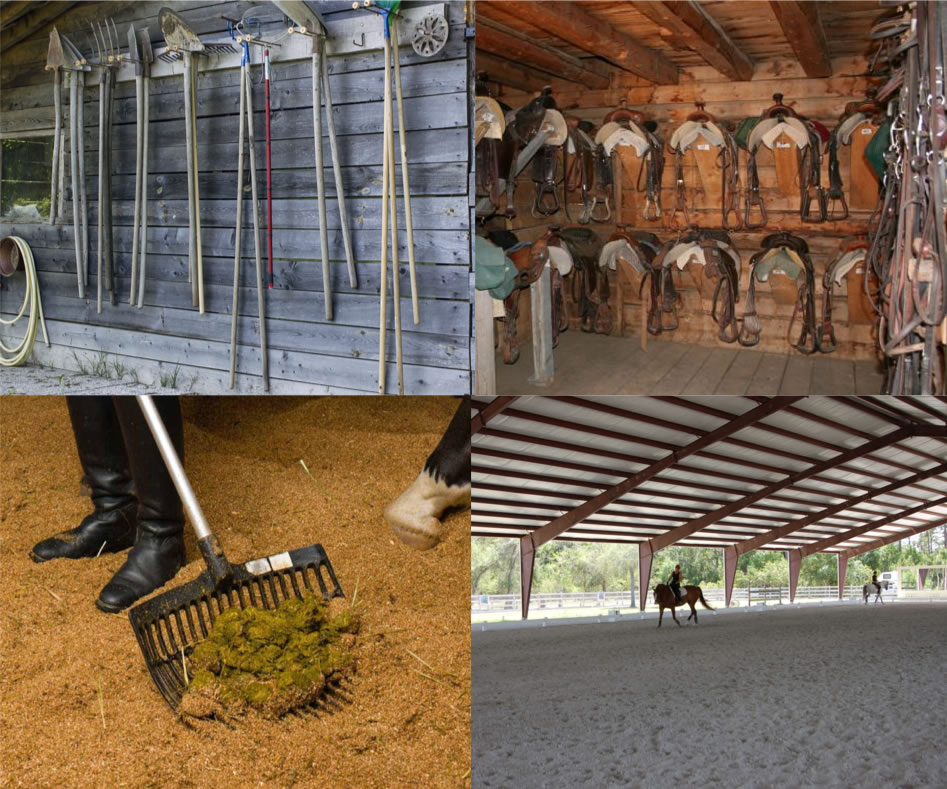In light of the COVID-19 pandemic, many equine owners and business operators are concerned for how to care for horses while taking precautions to keep people healthy. Click each hotspot to learn tips and recommendations for equine facilities while dealing with COVID-19 social distancing recommendations.
Remember, there are many reputable sources for COVID-19 information, precautions, and resources. Visit the sites below for more information on COVID-19 and UTIA’s response. The University of Tennessee Equine Extension Program will remain operational during this period to aid in answering questions regarding equine management, health, nutrition, and more.
Centers for Disease Control and Prevention
University of Tennessee Institute of Agriculture

Commonly Touched Areas
Disinfect commonly touched surfaces including broom, manure fork, feed/water bucket and wheelbarrow handles, along with farm machinery or vehicle controls (ex. steering wheel, shifter, door/cab handles). Gate handles, stall door latches, faucets, and other areas that are frequently touched by workers, boarders, etc. should also be routinely disinfected. For disinfection, diluted household bleach solutions (1/3 cup bleach per gallon of water), alcohol solutions with at least 70% alcohol, and most common EPA-registered household disinfectants should be effective. If possible, consider assigning each worker their own set of labelled equipment to reduce sharing germs between individuals. Consider posting signage to encourage workers/boarders/visitors to wash their hands prior to working in the barn.
Employee, Boarder, and Visitor Scheduling
Despite social distancing recommendations, horses and other animals still require routine care. Consider adjusting barn worker’s schedules to minimize time where several people are at the facility at once. Help to encourage boarders or owners to care for their animals in shifts to reduce person-to-person contact. Create a schedule where people can sign up for a time to help feed, muck stalls, or check horses to prevent busy times, and ensure livestock receive proper care. UTIA has developed signs and notifications that can be placed around facilities at this website.
Employers should work with their local and state health departments to ensure appropriate local protocols and guidelines, such as updated/additional guidance for cleaning and disinfection are followed, and employees/workers are trained appropriately. Create a plan of action for what needs to be done at your farm in case you, other management personnel, or key care providers become ill. Sharing information is important to ensure animals are well cared for, no matter the situation.
Social Distancing and Safety
Amidst social distancing, remember that it is unsafe to ride or work around horses alone. In case of an accident or emergency, it is important to have someone nearby to help. Use proper safety precautions and best management practices while handling and working, including wearing a helmet while riding. Always use recommended social distancing and good hygiene practices for social distancing, such as staying at least 6 feet away from others, washing hands for at least 20 seconds, and covering your mouth when sneezing or coughing. If you feel sick, stay home and ask for help from a fellow barn member or worker.
Common Areas
Practice social distancing by being aware of the number of people in enclosed spaces, such as tack rooms, and common areas. According to a recent study, COVID-19 can remain viable for up to 72 hours on stainless steel and plastic surfaces and 24 hours on cardboard, so it is important to remain vigilant in social distancing, hand-washing, and other practices as recommended by the CDC.
Read more about the stability of COVID-19, as published by Dr. Doremalen and colleagues in 2020.
Click here for more information from the CDC on COVID-19 prevention methods.